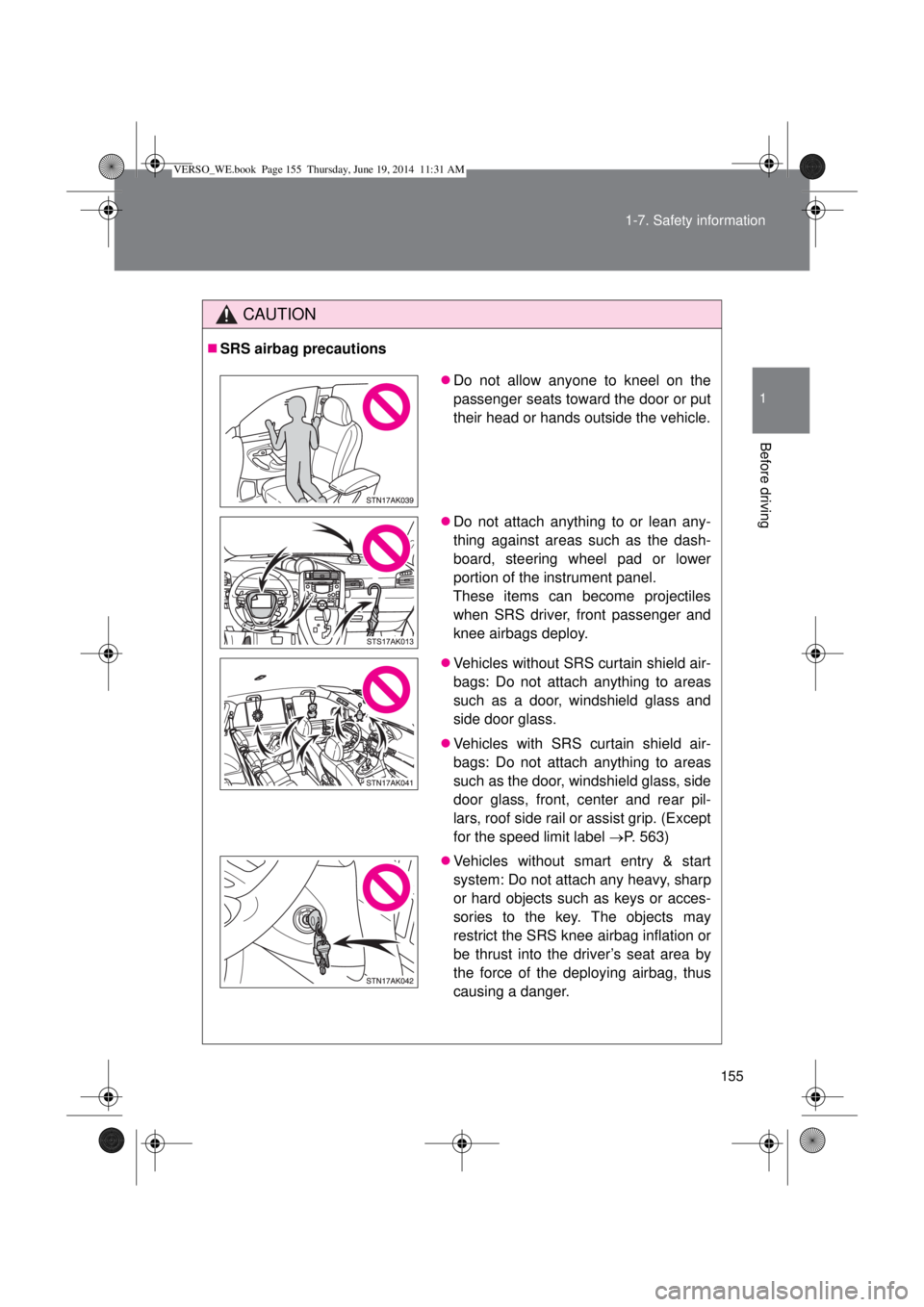Page 93 of 650

93 1-3. Adjustable components (seats, mirrors, steering wheel)
1
Before driving
CAUTION
Seat adjustment
Be careful not to get your hands pinched between the luggage cover and
the seat.
To reduce the risk of sliding under the lap belt during a collision, do not
recline the seat more than necessary. If the seat is too reclined, the lap
belt may slide past the hips and apply restraint forces directly to the abdo-
men, or your neck may contact the shoulder belt, increasing the risk of
death or serious injury in the event of an accident. Adjustments should not
be made while driving as the seat may unexpectedly move and cause the
driver to lose control of the vehicle.
After returning the seatbacks to the upright position
Observe the following precautions. Failure to do so may result in death or
serious injury.
Make sure the seatback is securely locked by pressing forward and rear-
ward on the top.
Check that the seat belts are not twisted or caught in the seatback.
NOTICE
Stowing the seat belts
The seat belts and the buckles must be stowed before you fold down the
rear seatbacks.
VERSO_WE.book Page 93 Thursday, June 19, 2014 11:31 AM
Page 95 of 650
95 1-3. Adjustable components (seats, mirrors, steering wheel)
1
Before driving
Removing the head restraints
Adjusting the height of the head restraints
Adjusting the rear seat head restraint (vehicles with rear seats)
Always raise the head restraint one level from the stowed position when
using.
CAUTION
Head restraint precautions
Observe the following precautions regarding the head restraints. Failure to
do so may result in death or serious injury.
Use the head restraints designed for each respective seat.
Adjust the head restraints to the correct position at all times.
After adjusting the head restraints, push down on them and make sure
they are locked in position.
Do not drive with the head restraints removed.
Pull the head restraint up while pressing
the lock release button.
Make sure that the head restraints are
adjusted so that the center of the head
restraint is closest to the top of your ears.
VERSO_WE.book Page 95 Thursday, June 19, 2014 11:31 AM
Page 99 of 650
99 1-3. Adjustable components (seats, mirrors, steering wheel)
1
Before driving
Stow the seat belt tabs in the
cover set in the roof as shown.
Extracting the belt
Push the tab.
Remove the tabs from the
cover.
VERSO_WE.book Page 99 Thursday, June 19, 2014 11:31 AM
Page 153 of 650

153 1-7. Safety information
1
Before driving
CAUTION
SRS airbag precautions
Observe the following precautions regarding the SRS airbags.
Failure to do so may cause death or serious injury.
The driver and all passengers in the vehicle must wear their seat belts
properly.
The SRS airbags are supplemental devices to be used with the seat belts.
The SRS driver airbag deploys with considerable force, and can cause
death or serious injury especially if the driver is very close to the airbag.
Since the risk zone for the driver’s airbag is the first 50 - 75 mm (2 - 3 in.)
of inflation, placing yourself 250 mm (10 in.) from your driver airbag pro-
vides you with a clear margin of safety. This distance is measured from the
center of the steering wheel to your breastbone. If you sit less than 250
mm (10 in.) away now, you can change your driving position in several
ways:
• Move your seat to the rear as far as you can while still reaching the
pedals comfortably.
• Slightly recline the back of the seat.
Although vehicle designs vary, many drivers can achieve the 250 mm
(10 in.) distance, even with the driver seat all the way forward, simply
by reclining the back of the seat somewhat. If reclining the back of your
seat makes it hard to see the road, raise yourself by using a firm, non-
slippery cushion, or raise the seat if your vehicle has that feature.
• If your steering wheel is adjustable, tilt it downward. This points the air-
bag toward your chest instead of your head and neck.
The seat should be adjusted as recommended above, while still maintaining
control of the foot pedals, steering wheel, and your view of the instrument
panel controls.
Vehicles with SRS curtain shield air-
bags: The portion of the front, center
and rear pillar garnish, or roof side rail
garnishes containing the curtain shield
airbags inside is scratched, cracked or
otherwise damaged.
VERSO_WE.book Page 153 Thursday, June 19, 2014 11:31 AM
Page 155 of 650

155 1-7. Safety information
1
Before driving
CAUTION
SRS airbag precautions
Do not allow anyone to kneel on the
passenger seats toward the door or put
their head or hands outside the vehicle.
Do not attach anything to or lean any-
thing against areas such as the dash-
board, steering wheel pad or lower
portion of the instrument panel.
These items can become projectiles
when SRS driver, front passenger and
knee airbags deploy.
Vehicles without SRS curtain shield air-
bags: Do not attach anything to areas
such as a door, windshield glass and
side door glass.
Vehicles with SRS curtain shield air-
bags: Do not attach anything to areas
such as the door, windshield glass, side
door glass, front, center and rear pil-
lars, roof side rail or assist grip. (Except
for the speed limit label P. 563)
Vehicles without smart entry & start
system: Do not attach any heavy, sharp
or hard objects such as keys or acces-
sories to the key. The objects may
restrict the SRS knee airbag inflation or
be thrust into the driver’s seat area by
the force of the deploying airbag, thus
causing a danger.
VERSO_WE.book Page 155 Thursday, June 19, 2014 11:31 AM
Page 181 of 650

2When driving
181
2-1. Driving procedures
Driving the vehicle ............ 182
Engine (ignition) switch
(vehicles without smart
entry & start system)....... 196
Engine (ignition) switch
(vehicles with smart
entry & start system)....... 200
Multidrive .......................... 206
Automatic transmission .... 212
Manual transmission......... 220
Turn signal lever ............... 224
Parking brake ................... 225
Horn .................................. 227
2-2. Instrument cluster
Gauges and meters .......... 228
Indicators and warning
lights ............................... 233
Multi-information display ... 239
2-3. Operating the lights and
wipers
Headlight switch ............... 251
Fog light switch ................. 258
Windshield wipers and
washer ............................ 259
Rear window wiper and
washer ............................ 2642-4. Using other driving systems
Cruise control.................... 265
Speed limiter ..................... 269
Toyota parking
assist-sensor .................. 272
Stop & Start system .......... 280
Driving assist systems ...... 287
Hill-start assist control....... 293
2-5. Driving information
Cargo and luggage ........... 295
Winter driving tips ............. 298
Trailer towing
(except Morocco) ............ 302
VERSO_WE.book Page 181 Thursday, June 19, 2014 11:31 AM
Page 185 of 650

185 2-1. Driving procedures
2
When driving
Engine speed while driving (vehicles with a Multidrive or an automatic
transmission)
In the following conditions, the engine speed may become high while driving.
This is due to automatic up-shifting control or down-shifting implementation
to meet driving conditions. It does not indicate sudden acceleration.
The vehicle is judged to be driving uphill or downhill
When the accelerator pedal is released
When the brake pedal is depressed while “SPORT” mode is selected
Breaking in your new Toyota
To extend the life of the vehicle, the following precautions are recommended
to observe:
For the first 300 km (200 miles):
Avoid sudden stops.
For the first 800 km (500 miles):
Do not tow a trailer.
For the first 1000 km (600 miles):
• Do not drive at extremely high speeds.
• Avoid sudden acceleration.
• Do not drive continuously in the low gears.
• Do not drive at a constant speed for extended periods.
Drum-in-disc type parking brake system
Your vehicle has a drum-in-disc type parking brake system. This type of
brake system needs bedding-down of the brake shoes periodically or when-
ever the parking brake shoes and/or drum are replaced. Have any autho-
rized Toyota dealer or repairer, or another duly qualified and equipped
professional, perform the bedding down.
VERSO_WE.book Page 185 Thursday, June 19, 2014 11:31 AM
Page 252 of 650
252 2-3. Operating the lights and wipers
Turning on the high beam headlights
With the headlights on, push
the lever forward to turn on the
high beams.
Pull the lever back to the center
position to turn the high beams
off.
Pull the lever toward you to
turn on the high beams.
Release the lever to turn them off.
You can flash the high beams
with the headlights on or off.
Manual headlight leveling dial (vehicles with halogen headlights)
The level of the headlights can be adjusted according to the number
of passengers and the loading condition of the vehicle.
Raises the level of the head-
lights
Lowers the level of the head-
lights
VERSO_WE.book Page 252 Thursday, June 19, 2014 11:31 AM